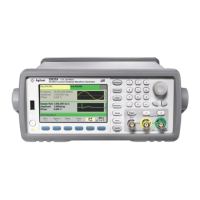Front-Panel Menu Operation Introduction
1. Select the function, frequency, and carrier amplitude.
Press the Waveforms key and then press Sine. Press the Frequency, Amplitude, and Offset softkeys to con-
figure the carrier waveform. For this example, select a 5 kHz sine wave with an amplitude of 5 Vpp, with 0 V offset.
2. Select FSK.
Press Modulate and then select FSK using the Type softkey. Then press Modulate to turn modulation on. Notice
the status message "FSK Modulated" at the top left of the display.
3. Set the "hop" frequency.
Press the Hop Freq softkey and then set the value to 500 Hz using the numeric keypad or the knob and cursor
keys. If you use the numeric keypad, be sure to finish the entry by pressing the Hz softkey.
4. Set the FSK "shift" rate.
Press the FSK Rate softkey and then set the value to 100 Hz using the numeric keypad or the knob and cursor
keys.
At this point, the instrument outputs an FSK waveform.
Output PWM Waveform
You can configure the instrument to output a pulse width modulated (PWM) waveform. PWM is only available for the
Pulse waveform, and the pulse width varies according to the modulating signal. The amount by which the pulse width
varies is called the width deviation, and it can be specified as a percentage of the waveform period (that is, duty cycle)
or in units of time. For example, if you specify a pulse with 20% duty cycle and then enable PWM with a 5% deviation,
the duty cycle varies from 15% to 25% under control of the modulating signal.
To change from pulse width to pulse duty cycle, press Units.
30 Agilent 33500 Series Operating and Service Guide

